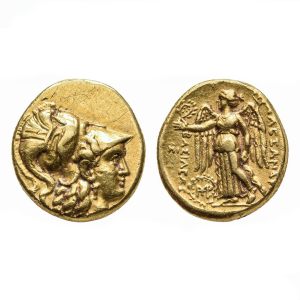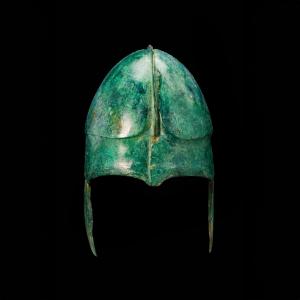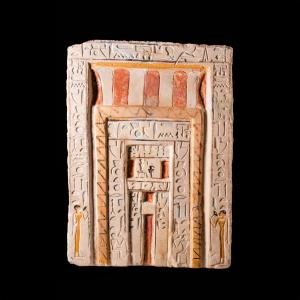
Circa 311-300 BC Gold coin of the Kings of Macedonia, Alexander III “the Great” (336-323 BC), minted under Seleucus I Nicator, Babylon. Starting bid: £1,000 ($1,276)

Rare Apulian red-figure ceramic bell krater from the Como Group, circa 350-300 BC, depicting the Temple of Dionysus. Starting bid: £2,000 ($2,551)

Chalcidian hammered tin bronze helmet, ca. 500-400 BC, whose shape was first depicted on pottery from the Euboean city of Chalcis. Opening bid: £4,000 ($5,103)

Egyptian painted limestone false door belonging to Itet, priestess of the goddess Hathor and lady-in-waiting to the king. Opening bid: £8,000 ($10,205)

Hellenistic gold ring, circa 300-100 BC, with large hexagonal multi-stage setting and red cabochon in the centre. Starting bid: £2,000 ($2,551)
On offer: exemplary Roman, Greek and Byzantine gold and silver coins, rare cultural art, relics and classic European weapons as well as exquisite Islamic pieces
—Dr. Ivan Bonchev, Director, Apollo Art Auctions
LONDON, UK, August 16, 2024 /EINPresswire.com/ — Some of history’s most fascinating artifacts have passed through the doors of Apollo Art Auctions’ elegant gallery in central London. On August 24 and 25, in an online-only format, a new selection of valuable coins, ancient art and antiquities will continue Apollo’s tradition of offering only the finest authentic examples of material culture from major civilizations. The opening session of the two-day event will include a wealth of exceptional coins from the Roman Empire, Greek and Byzantine periods; while the second day of the e-sale will feature art treasures and antiquities from classical Europe, Egypt, the Middle East, India, China and the Islamic world. Each item has been carefully examined by a top specialist from Apollo’s team of experts. Bid in absentia or live online via LiveAuctioneers.
Numismatists, both advanced and novice, have 377 lots to choose from, with sought-after gold coins leading the selection. A solidus (gold) of Constantius II, Caesar Constantius, Thessalonica AV, circa 337-361 AD, weighing 4.61g, features on the obverse a diademed, draped and armoured bust of a Constantius facing right. The reverse shows the esteemed ruler standing left, holding a sceptre and vexillum, with two signa to his right. The auction starts at £1,000 ($1,276).
A stunning gold coin of Alexander III “the Great” (336-323 BC), King of Macedonia, was minted under Seleucus I Nicator of Babylon. The obverse depicts Athena facing right wearing a Corinthian helmet with a griffin on the bowl, as well as an earring and a pearl necklace. The reverse depicts Nike facing left with her wings spread, holding a laurel wreath and a pen. This coin weighs 8.54g and opens at £1,000 ($1,276).
A silver coin dated circa 310-311 BC, issued by Antigonus I Monophthalmos, King of Macedonia, AS Strategos of Asia (320-303/5 BC), features on its obverse a detailed head of Heracles facing right, wearing a lion skin headdress with his paws tied together in front of his neck. The reverse of the coin depicts Zeus seated on his throne facing left, holding an eagle and a long sceptre. This 17.26g example requires a starting bid of £1,000 ($1,276).
Another silver highlight is the 14g (silver) tetradrachm from Macedonia, Akanthos, AR, dating to c. 430-390 BC, decorated on the obverse with the image of a lion with raised head charging a bull. The reverse is nicely decorated with a four-part square with granulated raised fields, all set within a recessed square. Bidders are referred to the example in the reference work Les Tetradrachmes d’Akanthos by J. Desneux. The starting bid is £800 ($1,021).
In terms of looks, it would be hard to beat the AR (silver) “Travelling with Caesar” denarius from the Julius Caesar Military Mint, dated April-August 49 BC. The striking obverse depicts an elephant advancing to the right and trampling on a horned serpent, while the excerpt (space below the image) contains the word “CAESAR.” The reverse depicts a number of emblems of the pontificate, including a simpulum, aspergillum, securis and apex. The coin requires a starting bid of £500 ($638).
The August 25 auction, featuring 583 lots of ancient art and antiquities, includes many dozens of exceptional Egyptian treasures. One of the top prizes is a painted limestone false door that belonged to Itet, priestess of the goddess Hathor and lady-in-waiting to the royal family, dating from the end of the Old Kingdom to the beginning of the First Intermediate Period, circa 2181-2160 BCE. It is beautifully decorated and inscribed with Itet’s titles and names, as well as formulas to the gods Anubis and Ptah-Sokar in favor of the deceased. The auction specimen is similar to one in the MET Museum’s collection. Its remarkable provenance shows that it was most recently owned by a London collector and before that by a Mayfair (London) family. Before that, it was the property of a London professor in the late 1970s. The relic will be presented to its new owner with a report by Simone Musso, a consulting curator of Egyptian antiquities at the Stibber Museum in Florence, Italy, and a member of the Nuri Archaeological Expedition. The opening bid is £8,000 ($10,205).
An Egyptian bronze dagger of unusual design has a curved guard next to a pointed blade tapering to a point, with an elaborate openwork pommel that flares out to attach an oval openwork bone end. The weapon dates from the Middle Kingdom to the Second Intermediate Period, circa 2055–1640 BC. Like the False Door of Itet mentioned above, the dagger resembles a specimen in the MET Museum’s collection. It measures 310 mm x 60 mm (12.2 in x 2.4 in) and weighs 250 g. Most recently owned by an art expert from Oxfordshire, it was previously in an old collection from Ontario, Canada, created in the 1980s. It comes with an expert historical report by Alessandro Neri of Florence, Italy, and is available to bid from £3,000 ($3,827).
Ancient weapons of war are a consistently popular category in Apollo Art Auctions’ specialty list, and on August 25 there is sure to be strong competition for a hammered tin-bronze Chalcidian helmet dating to around 500-400 BC. Its shape was originally depicted on pottery believed to have come from the Euboean (ancient Greek) city of Chalcis. Its details include curved cheek pieces, a very short teardrop-shaped nose guard, and open curves on the sides designed to improve communication on the battlefield. The helmet is similar to an example sold at Christie’s live auction #1679. It has a long line of London and continental European provenance stretching back to the Belgian F. Breydel collection of the 1970s. It will be presented to the highest bidder with an expert historical report by Alessandro Neri. Opening bid: £4,000 ($5,103)
The second session opens with Mediterranean ceramics. The offerings include high-quality Apulian, Attic, Villanovan, Faliscan and Etruscan-Corinthian vessels. A rare bell-krater of Apulian red-figure pottery dating to around 350-300 BC has been identified as a product of the Como Group. Side A is painted with a scene of two men in tunics conversing in the Temple of Dionysus. Side B of the programme shows a naked youth, probably Dionysus, standing before an altar and holding a long thyrsus, and maenad also holding a thyrsus. It measures 390 mm x 365 mm (15.4 in x 14.37 in) and is similar to an example sold at Christie’s on 9 December 2008. Its provenance in Britain and continental Europe can be traced back to 1982. It is accompanied by an expert historical report by Alessandro Neri and will be opened for bidding at £2,000 ($2,551).
Collectors of antique jewellery can be assured that a first-class selection of rings, necklaces, earrings, pendants, bracelets and jewelled rings awaits them at Apollo’s session on August 25. Just one of the many attractive options is a Hellenistic gold ring dating to around 300-100 BC, featuring a large hexagonal multi-tiered setting with a bright red cabochon at its centre. It weighs 24.4g and comes with an authenticity report by antique jewellery specialist Sami Fortune. Opening bid: £2,000 ($2,551)
Apollo Art Auctions’ Ancient Coins, Art and Antiques auction on Saturday/Sunday 24-25 August 2024, an online-only event with bidding via LiveAuctioneers, begins at 7am US Eastern Time/12pm GMT on both days. Apollo accepts payments in GBP, USD and EUR and ships worldwide. There are no import fees for most antiques shipped to the United States. All packing is done in-house by white glove specialists. Questions: Please call +44 7424 994167 or email [email protected]. Visit Apollo Art Auctions online at www.apolloauctions.com
Dr. Ivan Bonchev
Apollo Art Auctions
+44 7424 994167
Send us an email here
Visit us on social media:
on facebook.
LinkedIn
Instagram
TikTok
Other
![]()




